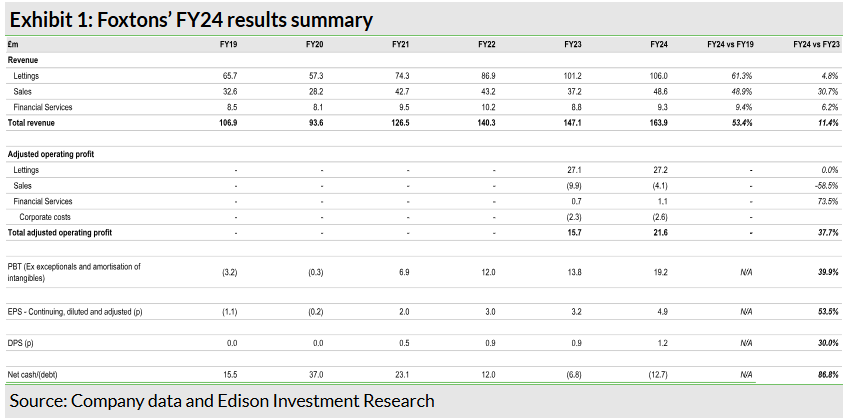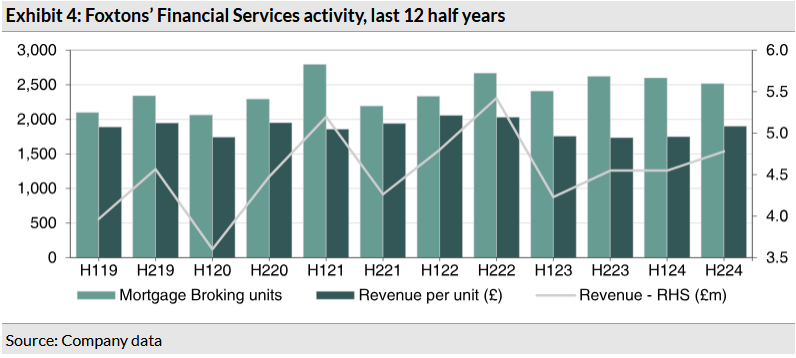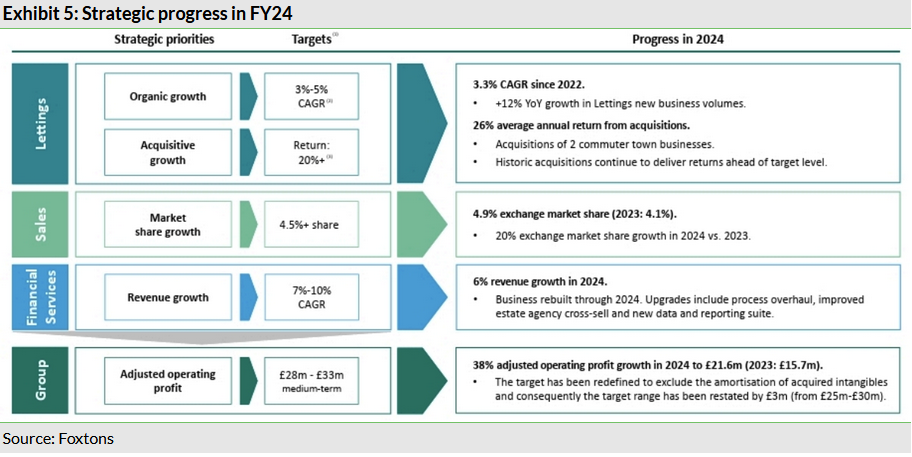Foxtons Group’s FY24 results showed revenue and adjusted operating profit growth of c 11% and c 38%, respectively, reflecting the developing success of the company’s strategic vision. This suggests that its medium-term targets, particularly the revised adjusted operating profit target of £28m–33m, are coming increasingly into focus. We believe market share is being gained across all divisions. We maintain our estimates and our 134p per share valuation, though risks appear to be skewed to the upside if market momentum continues, which could be supported by a further easing of interest rates.

FY24 results were modestly ahead of expectations, with revenue up 11.4% to £163.9m, largely driven by the strength of the Sales division. Total adjusted operating profit increased 37.7% to £21.6m, implying robust margin expansion from 10.7% to 13.2%, driven in part by the benefits of investment in personnel. Adjusted PBT rose 39.9% to £19.2m, and EPS (excluding exceptionals) expanded by 53.5% to 4.9p/share. The final dividend was increased by 36% to 0.95p/share, implying full year dividend growth of 30% to 1.17p/share and dividend cover of more than four times. Net debt increased from £6.8m in FY23 to £12.7m, as operating cash inflows were offset by M&A and other outflows.
Further Strategic Progress in FY24
In 2023, CEO Guy Gittins set out a strategic vision to return Foxtons (LON:) to its former position as London’s go-to estate agent. In the FY24 results, Foxtons clearly demonstrated marked progress across all three divisions towards the four strategic priorities outlined, and with a solid start to FY25 and a helpful reduction in interest rates recently, we believe further progress is likely to be made. One of the very encouraging signs of success is the rapid move to a close to break-even result in H224 in Sales, from a loss-making position in FY23. If Foxtons continues to invest with such success, and the markets remain supportive, it seems likely the company could achieve its revised adjusted medium-term operating profit target of £28–33m. Foxtons is due to hold a capital markets day in Q225 to update investors.
Valuation: Retained at 134P, >100% Upside Potential
We maintain our FY25 and FY26 estimates, as the market in sales is being temporarily boosted by the government’s decision to increase stamp duty, and introduce FY27 estimates. However, given that FY25 has started well, with the under-offer pipeline at the end of February up 21%, it suggests that our forecast risks are skewed to the upside. We also maintain our 134p per share valuation.
FY24 results saw growth in all divisions, but primarily in Sales as action to improve the company’s presence and market share gained traction. The Foxtons Operating Platform is designed to improve motivation and brand awareness, and it appears to be paying dividends as staff turnover has declined. Overall, revenue and profits were up, and although net debt increased, it was mainly due to M&A activity. Without this investment, the balance sheet would have ended the period in a broadly neutral position. It is worth pointing out that adjusted operating profit increased to £21.6m, compared to the now revised medium-term target range of £28–33m (previously £25–30m, including amortisation of acquired intangibles).
The FY24 results came in modestly ahead of expectations, with revenue up 11.4% to £163.9m. This was largely driven by the strength of the Sales division, though Lettings and Financial Services revenue increased 4.8% and 6.2%, respectively. Total adjusted operating profit increased 37.7% to £21.6m, implying robust margin expansion from 10.7% to 13.2%, driven in part by the benefits of investment in personnel, which has pushed fee earner numbers and revenue per fee earner higher.
Adjusted PBT rose 39.9% to £19.2m, and EPS (excluding exceptionals) expanded 53.5% to 4.9p/share. The final dividend was increased by 36% to 0.95p/share, implying full year dividend growth of 30% to 1.17p/share and dividend cover of more than four times. Net debt increased from £6.8m in FY23 to £12.7m, as operating cash inflows of £24.7m were offset by £12.7m of M&A investment, a £4.9m working capital outflow, capital expenditure of £2.7m and £2.8m of dividend expenses.
Lettings Supported by Elevated Rates and Continued M&A
Total Lettings revenue increased 4.8% to £106.0m (2023: £101.2m) on the back of a c 11% increase in the overall lettings book to c 31,100 tenancies. The volume of lettings was up modestly, to 19,384, while the average revenue per unit increased 4.6% to £5,470, reflecting improved property management cross-selling and a change in mix to higher-fee new business volumes. Rental rates on new deals were flat as the supply-demand balance normalised, but prices overall remained at elevated levels.
Of the £4.8m increase in Lettings revenue, £4.3m was acquired revenue and £1.0m was additional interest earned on client monies, implying that organic growth was broadly flat. The Lettings adjusted operating margin remained strong at 25.6% (FY23: 26.8%), well above the average of the last six years.
The acquired revenue reflects an incremental two months of trading from Atkinson McLeod (purchased in March 2023), 10 months of Ludlow Thompson (bought in November 2023) and two months of Haslams and Imagine (acquired in October 2024). Divisional revenue included an additional £1m of interest earned on client monies held, which offsets the increased costs of managing clients’ money and compliance costs.
New business volume increased 12% but was offset by an expected temporary reduction in the volume of existing tenancies renewing/re-letting following the previous decision to lengthen tenancy terms in 2022 and 2023. This headwind is close to completely working its way through the tenancy book, but has resulted in a c 15% increase in tenancy lengths as part of a drive to improve the quality of recurring revenue.
Exhibit 2 below clearly shows that although the number of lettings in H124 and H224 was broadly similar to 2019, the average revenue per letting has risen by roughly a half as overall rates are now higher and the portfolio has an increased proportion of properties that are now managed, which delivers a higher fee.
Sales Outperforms the Market and Exceeds Target; H224 Was Almost Break Even
The volume of sales transactions increased by 29.7% to 3,725 units, with the average revenue per transaction lifting modestly to £13,038. Combined, these two levers drove a 30.7% increase in divisional revenue to £48.6m. According to TwentyCi, the sales market grew c 9% in the period compared to Foxtons’ growth, implying that the company increased its market share from 4.1% to 4.9%. This compares favourably with Foxtons’ market share target of 4.5%.
The small increase in average revenue per transaction reflects a 1% rise in the average price of properties sold, to £592k, while commission rates remained flat at 2.25%. The move in the average price of properties sold reflects company strategy and compares to a 1% decline in the average price of properties sold in the entire market, according to the Land Registry.
As previously noted, FY23 was a low point for the division with losses of £9.9m. Due to the investment in personnel and systems, as well as the improvement in volumes in particular, losses for the division were more than halved to £4.1m for the full year. The margin improved materially as well, from -26.6% in FY23 to -8.4%. However, this hides the fact that the H224 margin was only modestly negative, implying that a positive profit contribution from the division is possible in FY25.
Exhibit 3 below shows the volume of sales, revenue and revenue per unit over the last 12 half years. It shows half-yearly volumes in 2024 of c 1,900, up c 60% versus c 1,200 in H119 and H219. Revenue per unit is broadly unchanged, implying that total revenue was also up by c 60% in FY24 versus FY19.
Financial Services Followed the Sales Path, but Also Gained Market Share
Foxtons’ Financial Services division handled 5,115 units in the year, which was marginally up on FY23, and revenue per transaction increased by 4.5% to £1,824 as the mix moved in favour of new purchase activity (60% of volume) and away from lower-margin remortgage volumes (40%). As a result, overall revenue for the division rose 6.2% to £9.3m. The mix between new purchase activity and remortgage activity was evenly distributed in FY23.
Operating profit was up strongly, from £0.7m to £1.1m, as the mix of business was materially better than in the previous period. As a result, the drop-through rate of additional revenue to operating profit was nearly 90% and the margin recovered from 7.4% to 12.2%.
Over the last 12 half years, volumes have trended modestly higher, but revenue per transaction has shown some volatility. Financial Services remains the smallest division of the group by a long way, but it is profitable and a complementary component of Foxtons.
Valuation
FY25 Outlook Is Encouraging; Forecasts and Valuation Retained
In the key lettings market, according to management, tenant demand remains high and this is supporting rental prices at the current elevated level, while stock levels continue to improve steadily. The growing supply of stock, coupled with Foxtons’ market-leading position and Operating Platform imply that the company is well-positioned to grow market share organically. M&A is likely to remain a feature, as witnessed with the £2.3m purchase of Marshall Vizard in Watford in February 2025. Foxtons expects that the forthcoming Renters’ Rights Bill, currently going through Parliament, may cause some turbulence, but ultimately will encourage landlords to choose professional agents, creating opportunity.
Foxtons entered 2025 with an under-offer sales pipeline that was the best since 2016 and ‘notably’ higher than at the same point last year, underpinning Q1 activity, partly due to stamp duty changes. Although these changes may be temporarily boosting volumes, the recent cut in interest rates is supporting the market longer term and at the end of February, the under-offer pipeline was 21% ahead of the previous year. Assuming consumer confidence holds firm, the outlook for sales is positive.
We retain our existing FY25 and FY26 estimates and introduce FY27 forecasts in the financial summary below. We also retain our 134p valuation. On balance, the outlook for Foxtons is promising and investors can look forward to an update on strategy from the company in Q225.
Strategic Progress Evident in All Three Divisions
Two years ago, Foxtons set out four strategic priorities, designed to underpin the company’s medium-term profit target. In FY24, Foxtons again made good progress towards meeting all four and, therefore, towards meeting its revised adjusted operating profit target range of £28–33m.
In Lettings, it has so far achieved both its organic revenue CAGR target of 3–5% and its 20%+ annual return target on acquisitions, and looks set to continue to make further progress. In Sales, its market share target of 4.5% has been exceeded as it grew volumes by more than twice the rate of the underlying market in FY24, and in Services, growth has again moved closer to the 7–10% target range.
Given the success to date of this strategy and the underlying characteristics of the market, we believe Foxtons is likely to progress further. The company has announced it will host a capital markets day in Q225, so some or all of these priorities and targets may be reviewed and revised.





